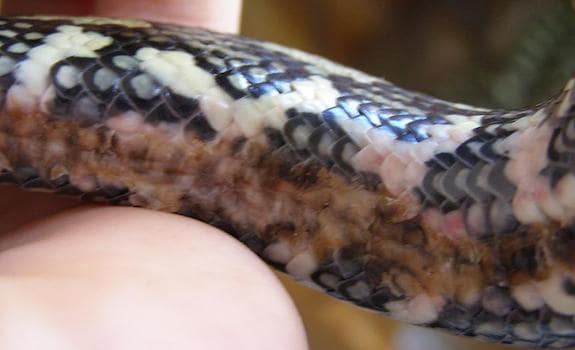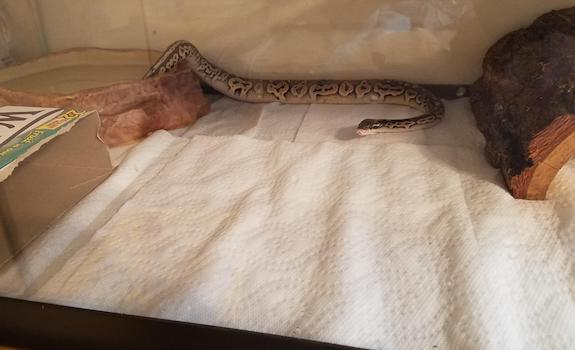Does your snake have abnormal-looking scales? You know, ones that differ in color from that of their normal scales or even look like they’re decaying or dead?
If so, you’ll want to act FAST as these types of scales are often times an early indication of scale rot in snakes.
But, what the heck is scale rot anyways? And is it serious?
Simply put, Scale Rot in snakes is a condition that commonly affects your snake’s scales causing them to have an infection.
If this continues to get worse, it would be best for your vet to look at this area on your snake. They can start your snake on antibiotics if the infection is very severe.
The good news? With a little at-home treatment and prevention methods, you can almost always get your snake’s scales back to normal.
To learn all that you need to know about scale rot in snakes, including how you can prevent AND treat it, just keep reading!
In This Article
Scale Rot Explained & What It Looks Like
Scale rot is a bacterial infection that is most commonly seen on snakes.
This type of bacterial infection is usually due to not keeping your snake’s enclosure clean and at the correct temperature or because your snake has injured itself.
These circumstances often create wounds that allow the bacteria to enter the body, causing an infection.
But don’t worry! With a little time and patience, you can easily treat these issues at home.
However, if your snake’s scale rot is very severe, they may need antibiotics from your local vet.
What Causes Scale Rot?
While there are many different things that can cause scale rot in your snake, these are a few of the most common reasons that your snake could have scale rot. Once you have determined the cause of scale rot, you can easily figure out what you need to change to keep this from happening.
Scale Rot Cause #1: Inappropriate Temperature
Your snake’s cage needs to be kept between 75 and 85 degrees Fahrenheit year round. In addition to this, they will also need a hotter side of their enclosure AND a cooler side.
Make sure that you have the thermometer placed in the cage in the area that your snake tends to be in the most. This will allow you to easily monitor temps.
BUT, don’t just throw in any old thermometer! You’ll want to avoid the cheap stick-on dial types as they are notoriously inaccurate… sometimes off by as much as a whopping 20 degrees!
Instead, opt for more reliable thermometers (opens in a new tab) to ensure your temps are accurate. The ones in that post are listed to help bearded dragon owners, but rest assured, they’ll work just fine for any reptile.
Scale Rot Cause #2: High Humidity

Most snakes need their enclosure’s humidity to be between 30 and 50%. If this is too high, it can easily cause them to have issues with their scales, sometimes even leading to scale rot.
Humidity plays a HUGE role in them shedding correctly. If your snake does not fully shed their scales, the areas of the retained shed can be a place that scale rot can occur.
If you need a hygrometer to measure your tank’s humidity, you can hit the thermometer link above for a great selection that works for all reptile environments, not just bearded dragons.
Scale Rot Cause #3: A Dirty Cage
A dirty cage can make it easier for bacteria to infect your snake’s scales. As such, you should fully clean your snake’s cage once a month.
Additionally, you would need to do spot cleanings in between cleanings and more frequently if your snake makes a huge mess.
When cleaning your snake’s enclosure, make sure to take everything out, fully clean it, let it dry. Then replace the substrate and set your snake’s enclosure back up.
Also, be weary of toxic cleaners that can hurt your pet. Instead, opt for 100% safe veterinary grade cleaners such as F10SC disinfectant.
🤓 Expert Tip: Have a stinky snake cage but don’t want to constantly have to be stuck cleaning it from top to bottom? No problem! Check out this all natural probiotic and enzyme rich cleaner that is tough on stench and safe enough to spray while your snake is in their tank. Your nose will thank you.
Scale Rot Cause #4: Trauma to Your Snake
If something has damaged your snake’s scales, this can lead to scale rot. Often times, items within your snake’s enclosure that can easily scratch their skin are the culprits behind scale rot.
When a snake’s skin is broken, it’s much easier for an infection to set in.
As such, be sure to remove anything poky or sharp from the enclosure.
Also, if you feed live mice or rats to your snake and they fail to eat them in a timely manner, they can actually bite your snake and damage their scales.
This is why it is SO important to monitor live food and ensure your snake consumes it.
How Do I Know If a Snake has Scale Rot? Consider These Scale Rot Symptoms…
As with any health issue that your snake may have, the earlier that you find the problem, the easier it will be for you to treat your snake.
Early detection of scale rot will ensure that your snake barely suffers and that the treatment is the least expensive.
Here are 3 early signs of scale rot to look out for…
Scale Rot Symptom #1: Discoloration

There may be a discoloration of the scale’s underneath of your snake’s body.
These are known as the ventral scales. The region MOST affected is right above the cloacal and anal region of your snake.
These scales may look red, greenish-black, yellow, or brown.
However, you’ll want to pay special attention as the red ulcerations that are caused by scale rot can easily be confused with shedding.
To distinguish between the two, look for other symptoms such as blisters or pus.
While the ventral scales are usually the first to be affected with scale rot, the tail and any other areas on your snake can also be affected.
A such, you should examine your snake’s scales every few days to make sure that there is nothing that could cause your snake any health issues.
This exam should take no more than a minute or two. However, make sure you are not handling or examining your snake too closely after a meal as they may regurgitate their food.
Scale Rote Symptom #2: Blisters on Your Snake’s body
An early sign that your snake may have scale rot is small blisters on their body. These small fluid-filled sacs will appear on the scales of your snake.
Blisters will usually appear on the scales that have the MOST contact with the substrate. The fluid that is in these blisters is clear and yellowish.
Early blisters are usually not infected. When scale rot is not treated, these blisters can become infected because bacteria have entered the blister.
In very rare cases… fungi can even enter the blister and cause a fungal infection. Mites can also transmit bacteria into these blisters.
Once these blisters become infected, they will be red and oozes fluid. The whole area can become swollen, and the blister will eventually rupture.
In this area, the scales may even dislodge and fall off. Pus will then leak from the affected area when the snake sheds.
After your snake sheds, sores and ulcers will appear where the blisters are. If your snake has several blisters, these may combine to make infected blots of skin.
If the blisters are not untreated, bacteria can enter your snake’s bloodstream cause septicemia.
If scale rot is not properly treated, this disease can kill your snake within just a few days.
Scale Rot Symptom #3: Raised Scales
Scale rot typically causes blood to pool under the scales. These scales that have blood underneath them will become raised.
When running your hands down your snake’s body, you will easily feel these raised areas. If you feel any abnormal scales closely look at these areas for any other signs of scale rot.
These are three of the main signs to look out for when it comes to scale rot. The earlier that you notice any of these symptoms, the easier it will be for you to treat scale rot in your snake.
How Long Does It Take for Scale Rot to Heal?
Naturally, if your snake is suffering from scale rot you’ll want to know how quickly you can help them recover.
The answer to this question comes down to how severe the infection is…
Mild infections and those that are caught early, will typically clear up in 3 to 6 weeks. Your snake’s scales should look essentially back to normal after a few sheds.
However, more wide spread and severe infections have been known to take several months to clear up.
How Do You Stop Scale Rot? Try This Mild At Home Scale Rot Treatment!
If your snake has a mild scale rot, rest assured that you can treat this at home. However, if the condition is severe, you should take your snake to the vet ASAP to get the infection under control and stop it from spreading.
In severe instances, they may need antibiotics, debridement, or another treatment to help treat their scale rot.
As a forewarning, not all vets see snakes, so make sure that you call around to different vets in your area to ensure the one you visit is knowledgeable about them.
Step #1: Quarantine Your Snake

If you have more than one snake, take the one that is affected out of the enclosure and put it in a tank with NO substrate. Use paper towels for lining on the bottom.
This will allow the tank to be easily be cleaned and ensure the scale rot does NOT spread to your other snakes.
If your snake lives alone, it would be wise to still go ahead and remove their substrate and use paper towels until the infection is gone.
Step #2: Clean the Affected Scales
A chlorohexidine solution can be used to gently clean the affected scales twice a day.
You can also use diluted betadine solution of 3 parts water to 1 part betadine to soak this area. This mixture is especially helpful if a larger area of scales is rotting.
Try to soak the scales for 5 minutes. Do this 2 times a day for at least a week, but ideally two.
After the soaking, gently (remember, the scales are very tender!) dry the affected area with paper towels.
Step #3: Apply an Antibiotic Ointment
After the scales are dry, you’ll want to use an over the counter triple antibiotic ointment on this area. An ointment like Neopsorin works great BUT do not get the kind with pain relief. That goes for all ointments.
In more severe cases, your vet will provide a special, medicated ointment for you to apply in place of the weaker over the counter ones.
Step #4: Double Check the Cage
Lastly, you’ll want to make sure that your snake’s enclosure is clean and at the correct temperature and humidity.
A dirty cage set up can keep your snake’s scales from healing and can lead to an expensive vet visit.
Furthermore, the improper temperature and humidity can not only lead to scale rot BUT also other health issues.
If, after a week, your snake does not seem to be making any improvement or seems to get worse, it would be best to see your vet. Your snake may need antibiotics or stronger prescription cream.
Wrapping Up Scale Rot in Snakes
Unfortunately, scale rot in snakes is a VERY common thing that you should check your snake for regularly.
If you notice any scale abnormalities in your snake, it would be best to quarantine it from all your other snakes and start treatment.
If you are not making any progress with your treatment, then it is best to take your snake to the vet.
Your snake can easily get sick and even die from scale rot if the condition is left untreated.
However, with a little prevention and monitoring, you can catch scale rot very early in your snake. This will allow you to treat it and minimzie their suffering greatly.
